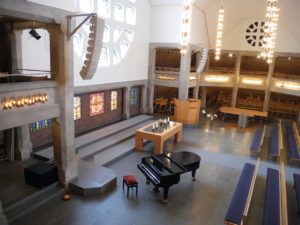
#nexolife One of the key applications for NEXO’s new ID84 column loudspeaker is in houses of worship. Globally, this market sector encompasses buildings that range from the extremely ancient to the ultra modern, architectural styles that range from the classical and gothic to the purpose-built auditorium with all manner of conversions in between, from old cinemas and bingo halls to office buildings. Yet, despite these dramatic differences in structure and acoustics, there are common characteristics that help the audio installer and integrator to define the ‘worship market’.
Devin Sheets is the chief engineer at Alpha Sound, a large and influential audio production company based in Oregon, USA. Alpha has gained quite a reputation for its system installation work in houses of worship in the Pacific Northwest.
“In the worship environment, we see two dominant building types. Type A, we could describe as the ‘cathedral- type’ of architecture typically found in Europe, but it’s not common for new purpose-built worship venues to go for this structure. In this classical style, there are very high ceiling spaces, hard surfaces of tile and stone, tall and narrow congregation areas, and highly reverberant interiors. Type B, which is very prevalent in the USA and increasingly throughout Asia, is the purpose-designed contemporary house of worship. Typically, these buildings are designed in the modern evangelical expression as a performance hall, a dry and acoustically dead ‘studio’ space, which uses a stage and concert sound and lighting to create a high-impact, concert-energy environment. Type A and B are two very different realms.
“With Type A buildings, our main challenge is to stop sound bouncing around and reflecting off the hard surfaces. We don’t want to change the aesthetics of the space, for example by putting up acoustic tiles or drapes. We want the space to be what it is acoustically, but we want to achieve clarity. So…where can we put the loudspeakers? A lot of people want them to disappear, which is one reason why distributed systems remain popular, in spite of their shortcomings. We see installations where line sources have been put up way way high, or even hidden in a false ceiling. That might be good for the visual profile but speakers are like people, they need space to breathe. Putting them inside what is effectively another cabinet is going to lead to a loss of control.
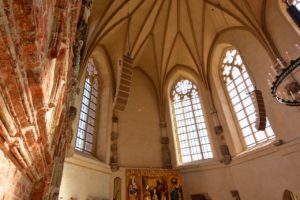
“Our number one challenge is to put the sound where the people are and keep it away from where they aren’t. It’s a simple concept but there are a lot of different philosophies as to how you achieve that. Some installers distribute speakers ALL around the venue, populating the space with many little speakers, each putting out a little bit of sound. It looks pretty when you print out the SPL coverage plot from a computer prediction software programme, but there is a discrepancy between the way that humans experience sound and the way computer software thinks about it. We’ve noticed that, in practice, the older distributed-system philosophies tend to spread bad sound very evenly around the room! Including all the places you don’t want it to go. Using little point-source systems that function as omnidirectional dispersion sources spreading sound everywhere without control produces a result that is a bit chaotic and muddy. The real way to solve this is to move toward line array technology with one or two centralised sources of the sound.
“For these reasons, we look for speaker modules that are extremely low-profile, as tiny as possible. NEXO’s GEO M6 compact system is the smallest legitimate line array design that we know of on the market that is actually a line array, rather than a bunch of point source cabinets clipped together in a J shape. Each M6 module is the size of a shoebox, which is a real selling point for us as integrators. The size factor is something that has put NEXO ahead of other brands, they make small stuff with high output that will actually do the job.”
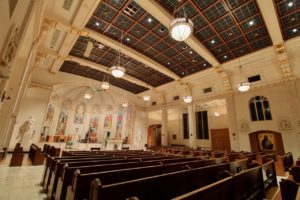
Alpha Sound has been a committed fan of NEXO loudspeaker technology for over twenty years, and Devin Sheets regards the NEXO GEO M6 line array system as his go-to solution for a mid-size sanctuary.
“The sound of the NEXO line arrays, which all use revolutionary patented technologies, is incredibly clean. Good box design is the first step for us to be able to maintain clarity and simplicity of sound. The brilliance of the NEXO solution is to use a HRW waveguide which converts the spherical wave front generated by a high-frequency compression driver into a flat or convex wavefront by means of an acoustic reflector. And it comes out without distortion, allowing us to aim high frequencies like a laserbeam to where we want them.
“In the low frequencies, NEXO cabinets use another patented technological innovation, the Directivity Phase Device (DPD), the unique feature that sets NEXO’s line array systems apart from the rest. We’ve watched for decades as other brands try to copy this technology, and they either don’t do it right or they get shut down for patent infringement anyway!”
The DPD is a separator. Placing the DPD in front of the membrane splits the radiating surface in two. So instead of having one 8” driver, there are two physical sources that are spaced 4” apart rather than 8” apart. Dividing by 2 the acoustic distance between coupled devices means the crossover point to the high frequency driver can be increased by one octave. Because the spacing is 4”, 10cm instead of 20cm, the 8” driver can be used beyond 850Hz, all the way up to 1.7kHz. With the crossover point at HF at 1.7kHz, there are benefits; these are very important frequencies, and the human ear is very sensitive to them. (Read more about our DPD here https://www.nexo-sa.com/blog/what-separates-nexo-from-other-systems/)
“What does this mean for the user? No distortion. The GEO M line array systems are extremely clear in the mid-frequencies range, not aggressive at all. By reducing the distortion, the system is more transparent, more natural, and offers more headroom. For most worship applications with difficult reverberant rooms, you have to have that frequency range clear because it is critical for the vocal content.”
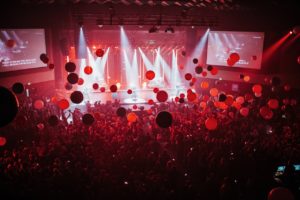
Whether one talks about churches, mosques, temples or synagogues, nearly all houses of worship seem to require a reverberant environment. This is partly the religious tradition, but it is also at the heart of how a building functions as a worship space, encouraging sound (speech, choral singing, congregational participation, music) to be uplifting and soaring. The voice of the worship leader and the singing of praise do best in a space that holds sound, and allows it to move around in ways that are sometimes imposing, sometimes inclusive.
“It can be described as an immersive experience, and reverberation helps create it,” says Devin. “Ironically we are now seeing quite costly immersive technologies being installed into modern churches to try and recreate what comes quite naturally in the classical Type A buildings.
“Speech is one of the hardest things to get right in the sense of amplifying it and keeping it sounding natural. In a church service, the fidelity issue for voice is not like a concert event, where we expect things to be manipulated. In a worship service, 95% of the content is speech; it’s not about a performance, it is about the message and the very purpose of the gathering. It places unique demands on clarity and fidelity. The amplification method should disappear.
“And it should not be seen! In a music environment, seeing more loudspeakers can be positively exciting for an audience (consider the highly visible PA systems for artists like U2, Metallica and AC/DC). In a religious environment, every step has been designed to serve a spiritual function. Congregations don’t generally want anything in their space that isn’t serving a specific religious function. Speakers are like aircon units – they serve a purpose but nobody wants to see them in the heart of their functional space!
“Of course, at the extreme end of the scale, where worship venues are putting on large musical events, they want something that really closely resembles the touring concert experience. This is the approach for many of the younger evangelical movements, which are motivated by more dynamic presentations – big awesome sound, big production, lighting rig, stage, smoke machines – they are actively seeking high concert production values. At this level, we look to NEXO for their large line array solutions like STM Series and GEO M12.
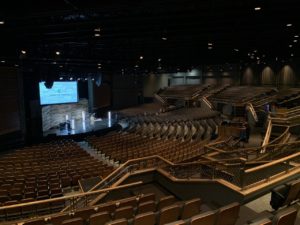
“But a lot of smaller churches, the contemporary Type B houses, also want to appeal to a younger demographic by revamping their worship styles and bringing in music talent, and they don’t have the budget to afford Yamaha RIVAGE or NEXO STM Series. I am able to offer them some really good mid-market options in the NEXO range, such as the GEO M10, which fits within the tighter budget. It’s amazing how huge the NEXO product can sound when you consider how small the package is, for example the P+ Series point source, and the new ID84 column speaker, which has a peak SPL of 136dB, will be ideal for environments which can’t architecturally accommodate a line array solution.”
As NEXO’s new ID84 starts to ship, Devin Sheets is starting to specify it for his clients, anticipating tight angular control of the sound and a clear midrange for vocals. “In addition to its extremely tiny footprint and low profile, I know that this column design will accomplish many of the elements of sonic performance that distinguish the GEO M Series in church applications.”
Devin also highlights the capability delivered by the whole of NEXO’s ID Series, including the compact ID24 and the super-compact cube that is the ID14. “It’s very convenient for the installer not to have to switch gears and use different products with different processors, different aesthetics, even down to different logos on the front of cabinets. Varied options in the ID Series still allow me to keep consistent sound, voicing and tuning and the way it operates over its entire dynamic range. I can mix and match NEXO products without worry.”
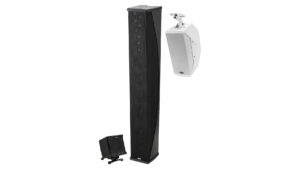
Devin concludes with some advice for audio system installers and integrators working in this field. “Demos, demos, demos. Wherever possible, demo your proposed system. If a demo is impossible, make the arguments about why and how the technology will produce a better sound. But the fact is, we are selling a sonic end result, so you should probably let your customers hear that before they have to choose!”
http://www.alphasound.tech/
PHOTOS
Poland: Church of the Castle of the Teutonic Order, Malbork
Sweden: Bethlehem Church, Gothenburg
Singapore: Riverlife Church
USA:
- Bayside Church, Sacramento
- St Mary’s Cathedral, Portland*
- Valley Life, Dallas*
- Cornerstone Church, Iowa
*Installation by Alpha Sound of Oregon.







